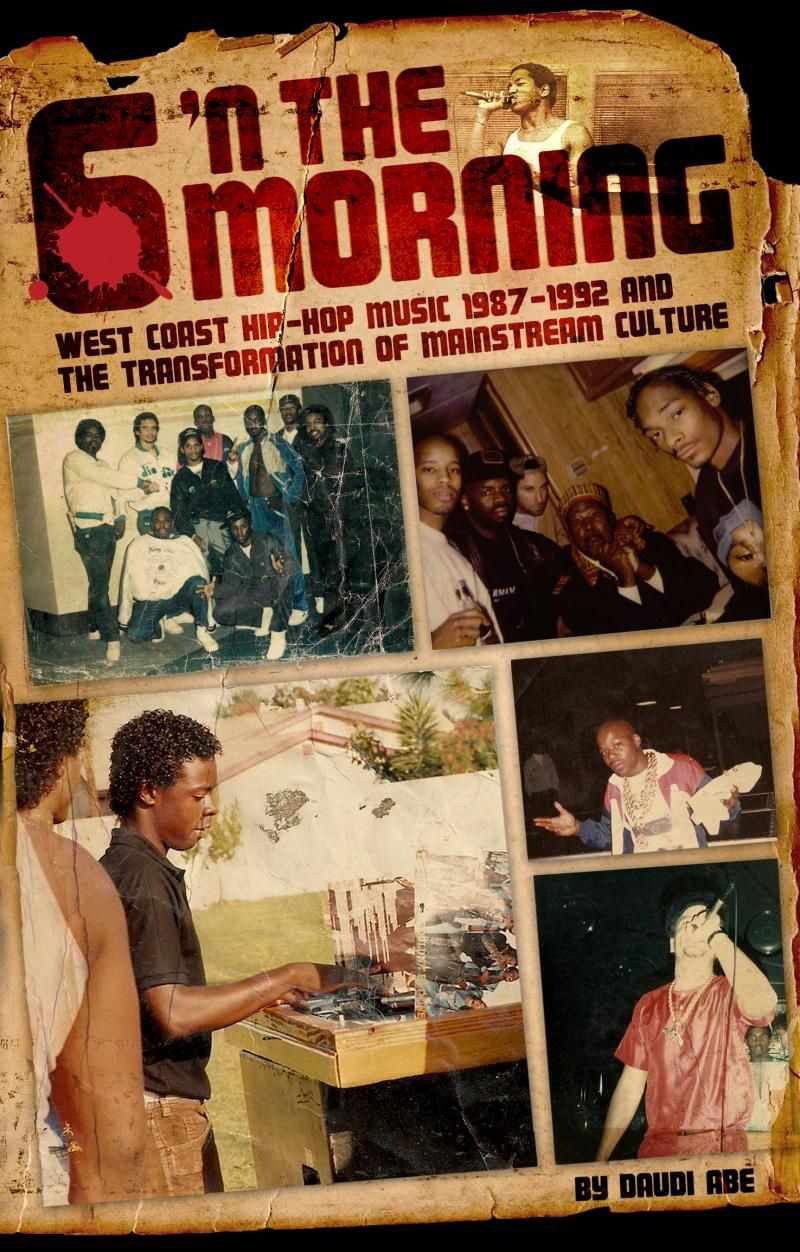Musically, it could be argued that the late 80’s and early 90’s holds the reputation of being one of the richest, shortest spans of musical flux. Cultural diversity practically exploded as rap seethed its way viscously across America, often to the dismay of older generations. Dr. Daudi Abe’s new book, ‘6 ‘n The Morning’ (out respect or adoration for the Ice T track of the same name), attempts to capture this volatile period, specifically between 1987 to 1992, with a defined focus on the West Coast of America.
With so much having happened in such a short period of time, you could be forgiven for not fully understanding the relevance and time-scale in which the West Coast brand of sun-parched, marijuana-hazed (although, as is explained, this was by no means an initial trait), and racially fuelled rap music came to be. And this account, combining short articles and first-hand accounts from figures who played in a part in the musical/cultural revolution, fittingly combines generous portions of history deep within its documentary-orientated approach to portray first-hand the true effects of race, (in)justice, and music had on America at that time.
For a large indication that the history of rap around 1988 to 1992 is of such relevance, yet is so widely misunderstood, look only to your local Topman or Primark to see hoards of twenty-something’s donning iconoclastic t-shirts complete with Dr. Dre album covers or TuPac portrait shots screen printed on the front. Even with access to Spotify, giving a cursory listen to the biggest albums from that time would still lack information on the cultural struggle which gave rise to this flux in the first place. As a twenty-something myself – one who, sadly (or not, as the case may be), is not the owner of an album-art inspired t-shirt – the aftermath and series of events that famed this era (no record label pun intended) are difficult to place having not been there, and Abe’s book provides a brilliant starting point. (Actually, I tell a lie, I was ‘there’ for 4 months, but that wasn’t enough time to learn to use a CD player).
I’ll come straight with you, even after an impressive Rap addiction around the ages of eleven and fourteen (before I even liked rock music!), ‘6 ‘n The Morning’ introduced a whole new world of musical material that hadn’t graced my ears previously. Its chronological approach, segmented by focuses on key releases and artists, had me seeking out and listening to the songs being mentioned as I read. Abe writes with such passion that it’s difficult not to stick the original ‘6 ‘n The Mornin’ track on to accompany Ice T’s account of the use of toasting at Uncle Jamm jam nights that began his rapping career.
From the off, short, distinct chapters documenting specific aspects worth noting, form the bulk of the book. Each chapter takes its name from recognisable lyrics about or from the songs/issues in question. This is a nice touch, but makes revisiting the book a complete pain if you have no idea what you’re looking for! Using lyrics to sub-head each chapter, or placing chapters within sections or artist focuses, might make navigation considerably easier.
This does provide a bite-sized way of consuming the book, yet such an approach causes vast amounts of repetition as names and events are introduced as if for the first time, multiple times. I must admit that this makes you both over-familiar with the relevant people involved, but also results in you feeling slightly babied as you begin to feel that maybe you aren’t trusted to remember who these people are? Greg Mack from KDAY radio, and Jerry Heller of NWA management fame are two names who appear regularly in this manner. This chapter structure and repetition causes ‘6 ‘n The Morning’ to read more like a collection than a book.
You may also notice a peculiar use of capitalisation. Throughout the entire book, ‘Black’ and ‘White’, in reference to race, appear as titles and not colour-based descriptions. It’s difficult to imagine that they’re not written this way to suggest a deeper meaning, yet the reasoning seems overly apparent and unnecessary. Race is a serious and intrinsic aspect of the book, but drawing focus to it unnecessarily acts to accentuate the problem at hand. I would argue that without capitalisation the issues of race would be apparent enough to all readers; however, I can empathise with the decision to do so.
In terms of content,’6 ’n The Morning’ is packed with direct insights that really put things into perspective. Talking about the changes of Compton and surrounding areas from predominantly white middle-class to black and minority classes, Abe pins down the root of gang culture in this west coast area. The cause, maliciously and actively, was white ‘clans’ roaming the areas in search of lone blacks to assault. For security, groups formed together to make themselves less likely to be singled out. This cause is almost so obvious, yet I myself had failed to consider it before.
The revolutionary backdrop to the book is also fascinating and complex. It begins with the Black Panthers, followed by that gang you all know so well called the Community Revolutionary Inter-Party Services (AKA the Crips), before moving to the “war on drugs” and larger gang warfare. Yet ultimately it’s the Rodney King beating and subsequent LA Riots that are the most thought provoking.
The effects on these cultural events had a direct impact on the music being made, and Abe captures this clearly. Importantly, rap music offered a view of black culture many teenagers (of all races) hadn’t seen before. It opened up the lid of a bucket full of racial injustice, drug addiction, prostitution, misogyny, and the need to be part of a gang.
Listening closely to the lyrics of Ice T, Ice Cube, the rest of NWA, & TuPac, to name just the most obvious, exposes this world to you. The help from Abe in picking out key lyrics is appreciated. Yet there isn’t always both sides of the argument presented. Beyond cursory mention, there is little-to-no information about east coast rappers beyond that of a name check. Why or how they rose to fame is rarely mentioned, and it often feels like they were only famous because they happened to be from New York – I’d imagine this unlikely, no matter what LL Cool J thinks.
Whilst the focus here is on west coast rap, the omission of an entire coast seems reckless, curtailing a vast amount of comparison. There is also, perhaps, the occasional lack of hindsight. With the book ending in ’92 just as TuPac’s career began to crest, Abe looks only briefly ahead. The TuPac Vs. Notorious B.I.G beef is mentioned fleetingly, and even after a lengthy chapter on TuPac’s ‘Brenda’s Baby’ that champions TuPac’s move away from the standard misogyny of other rappers like Ice Cube, Abe omits completely the news of TuPac being jailed for sexual assault in ’93.
The songs mentioned throughout the book acts as historical markers, mentioned more often than not for their relevance to specific events than for their inherent musical innovation; lyrics are often the only focus. The book’s subtitle reads: “West-Coast Hip Hop Music from 1987-1992 and the transformation of Mainstream Culture”, so in fact this is to be expected. Yet beyond some brief mentions of the use of a particular sample in a song, or short descriptive notions of the drum beat or bass line in a piece, there could be more to explain why west coast rap differed so greatly in a musical sense to east coast rap.
Clearly the amount of information in ‘6 ‘n The Morning is brilliant, providing a means of conveying personal and historical insight simultaneously. When it comes down to it, I’ve taken much away from this book and was engaged enough to read the whole thing in short spurts across 5 days. The content is wonderfully engaging, and you’d be hard pressed to be disinterested. The issues above are most niggles – small things that detract from the reading experience – but these are outweighed almost completely by the words themselves.




